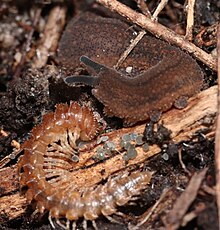
Back Panarthropoda Afrikaans جميع المفصليات Arabic Panarthropoda Azerbaijani Panarthropoda Bashkir Panarthropoda Byelorussian প্যানার্থোপোডা Bengali/Bangla Panarthropoda BS Panartròpodes Catalan Panarthropoda CEB Panarthropoda Czech
| Panarthropoda | |
|---|---|

| |
| Panarthropoda mencakup onychophora seperti Peripatopsis dan artropoda seperti kaki seribu polydesmid | |
| Klasifikasi ilmiah | |
| Domain: | Eukaryota |
| Kerajaan: | Animalia |
| Klad: | ParaHoxozoa |
| Klad: | Bilateria |
| Klad: | Nephrozoa |
| (tanpa takson): | Protostomia |
| Superfilum: | Ecdysozoa |
| (tanpa takson): | Panarthropoda Nielsen, 1995 |
| Filum | |
Panarthropoda adalah sebuah klad hewan yang diusulkan, yang mengandung semua filum hidup Artropoda, Tardigrada dan Onychophora. Panarthropoda juga mencakup hewan mirip cacing berkaki yang dikenal sebagai Lobopodia, sebuah kelompok parafiletik yang dimana nenek moyang bersama dan anggota basal (Kelompok tangkai, stem group) dari setiap filum panartropoda diperkirakan muncul.[3][4][5][6][7] Namun, terkadang istilah "Lobopodia" juga dikembangkan untuk mencakup tardigrada dan onychophora.
Ciri bersama dari Panarthropoda mencakup tubuh yang tersegmentasi, sistem saraf ventral berpasangan yang mirip tangga, dan anggota
| ||||||||||||||||||||||||||||||||||||||||||||||||||||||
| Intrahubungan yang diringkas dari Panarthropoda, dengan fokus kepada filogeni diantara lobopodia (bintang) dan panartropoda hidup. Hubungan antara kelompok-total dari panarthropoda hidup masih belum terselesaikan.[4][8] |
gerak berpasangan pada tiap segmen tubuh.[4][6][9]
- ^ Rota-Stabelli, Omar; Daley, Allison C.; Pisani, Davide. "Molecular Timetrees Reveal a Cambrian Colonization of Land and a New Scenario for Ecdysozoan Evolution" Current Biology, Volume 23, Issue 5 (31 January, 2013) | https://doi.org/10.1016/j.cub.2013.01.026
- ^ "The Shibantan Lagerstätte: insights into the Proterozoic–Phanerozoic transition". Journal of the Geological Society. January 2021. doi:10.1144/jgs2020-135.
- '^ Smith, Martin R.; Ortega-Hernández, Javier (2014). "Hallucigenias onychophoran-like claws and the case for Tactopoda". Nature. 514 (7522): 363–366. Bibcode:2014Natur.514..363S. doi:10.1038/nature13576. PMID 25132546.
- ^ a b c Ortega-Hernández, Javier; Janssen, Ralf; Budd, Graham E. (2017-05-01). "Origin and evolution of the panarthropod head – A palaeobiological and developmental perspective". Arthropod Structure & Development. Evolution of Segmentation (dalam bahasa Inggris). 46 (3): 354–379. doi:10.1016/j.asd.2016.10.011
 . ISSN 1467-8039. PMID 27989966.
. ISSN 1467-8039. PMID 27989966.
- ^ Giribet, Gonzalo; Edgecombe, Gregory D. (2019-06-17). "The Phylogeny and Evolutionary History of Arthropods". Current Biology (dalam bahasa English). 29 (12): R592–R602. doi:10.1016/j.cub.2019.04.057
 . ISSN 0960-9822. PMID 31211983.
. ISSN 0960-9822. PMID 31211983.
- ^ a b Chipman, Ariel D.; Edgecombe, Gregory D. (2019-10-09). "Developing an integrated understanding of the evolution of arthropod segmentation using fossils and evo-devo". Proceedings of the Royal Society B: Biological Sciences. 286 (1912): 20191881. doi:10.1098/rspb.2019.1881. ISSN 0962-8452. PMC 6790758
 . PMID 31575373.
. PMID 31575373.
- ^ Edgecombe, Gregory D. (2020-11-02). "Arthropod origins: Integrating paleontological and molecular evidence". Annual Review of Ecology, Evolution, and Systematics. 51 (1): 1–25. doi:10.1146/annurev-ecolsys-011720-124437. ISSN 1543-592X.
- ^ Kesalahan pengutipan: Tag
<ref>tidak sah; tidak ditemukan teks untuk ref bernamaOrtegaHernandez2016 - ^ Rota-Stabelli, O.; Kayal, E.; Gleeson, D.; Daub, J.; Boore, J.; Telford, M.; Pisani, D.; Blaxter, M.; Lavrov, D. (2010). "Ecdysozoan mitogenomics: evidence for a common origin of the legged invertebrates, the Panarthropoda". Genome Biology and Evolution. 2: 425–440. doi:10.1093/gbe/evq030. PMC 2998192
 . PMID 20624745.
. PMID 20624745.


